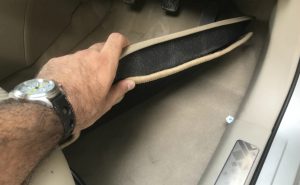Buying a car that has been under water – literally, not in the sense that its previous owner had it repo’d because he owed more in remaining monthly payments than the car was worth and so stopped making payments – is never a good idea.
It is a much worse idea than it once was, however.
A case-in-point will make the point.
A friend’s son inherited his dad’s old truck. One day, he forgot to set the parking brake and left it parked – or so he assumed – at the top of a hill. It went down the hill, into my friend’s cattle pond. It was under water, literally – physically – for a day or so, until my friend was able to pull his son’s truck out of the pond with his front-end loader.
Totaled?
If it hadn’t been an old truck, it would have been. But because it was an old truck, all it took to get it running again was drying it out – and draining the engine (and transmission) and refilling them with fresh oil (and lube), clearing the moisture out of the distributor (WD-40 works well; the “WD” stands for water displacement) and some jumper cables.
Back in business!
If it had been a newer truck – one with a computer rather than a carburetor – it would not have been so simple. It might not have been possible. Well, it probably wouldn’t have been worth it.
An under-water electronic car is apt to have endless electronic problems as a result of having been under water. It may not start or run normally – even after it has been dried out – because the water may have damaged electronics such as the computer that runs the fuel injection (as well as the ignition) and the many electronic sensors the computer depends upon to start the engine and keep it running normally.
But it’s much more than just that.
The heater controls in my friend’s son’s old truck consist of levers connected to cables. These open and close the airflow doors mechanically, allowing heat (and how much) to enter the truck’s cab.
Almost all late-model cars have electronic – that word, again! – climate controls. When you push a button – or even when you rotate a knob – a signal conveying what you want, in terms of hot and cold (and how much, of each) is sent to electronics that actuate the mechanisms. Water doesn’t hurt cables, if it’s dried out of them and the cables are lubed to keep them moving and from rusting.
Electronics, on the other hand.
That goes for the stereo, too. And – in many late-model cars and almost every new (2023) car, the LCD touchscreen. Give it a bath and it will probably never work right again. Ask anyone who’s dropped their smartphone in a pond.
Remember that in many cars that have these touchscreens, that is how you control most things. No touchscreen – no more controls.
There are also body control modules, which are min-computers that control things like the action of the power windows, which were once controlled with simple switches and simple wiring. The latter could be dried out and even replaced, if need be, for a sum that made it worth replacing them, if necessary.
A half dozen (or more) body control modules – and a wiring harness as thickly bundled and complex in its windings as the one in the Apollo lunar landers – not so much.
The cost to replaced all of this stuff – or even some of it – is so high relative to the worth of the car (or truck) after it has gone for a swim – or even a dip – that it isn’t worth paying it. That is is why insurance adjusters will almost always total a car (or truck) that has gone for a swim.
And that is why it’s really important to be sure you don’t buy a modern car (or truck) that’s been under water, even just a little bit. Water high enough to breach the door seals – or even partially immerse the car (or truck’s) underthings can be enough to ruin the car. Especially electric cars – which may become dangerous cars, if the battery has been compromised.
Trucks (and some SUV) are less vulnerable to water damage because they have more ground clearance and may also have more shielding to prevent water from getting at electronics that don’t do well when the get wet. But even they are vulnerable to catastrophic damage if the water gets too high – or they are driven through water that’s too high.
Every time this happens en masse – as in the wake of a flood, such as the recent one up in New England – cars and trucks that did go for a swim (or just a dip) and got totaled by their owner’s insurance company – are washed through the system, with “clean” titles that make it appear they’re just another used car (or truck). It’s easy to do because it’s easy to dry out a vehicle that went for a swim – which is why it’s so important to look for signs that it did.
Running a Carfax or similar vehicle history report may reveal title irregularities but it is not a guarantee. Neither is anything else in life – other than having to deal with the government’s hands in your pockets and its nose in your business. However, you can greatly increase the odds you won’t take a bath by using your own eyes – to look for signs that the vehicle you’re looking at might have been under water.
It goes without saying that buying a vehicle sight unseen (as online) is risky business – to cage a line from a movie about a Porsche that went for a swim. You can’t smell moldy carpets from two states away and it’s harder to see water marks on door panels when you’re not eyeballing them up close, yourself.
If you’re looking at the vehicle in person, you can pop the hood and look for signs of rust where it ought not to be, such as on metal parts that ordinarily don’t get wet such as the brake master cylinder and the lines feeding into it. Also the underside of the hood. If the car has been “detailed” extra due-diligence is called for, especially as regards the engine compartment. High pressure water used to clean the engine can have the same effects, by the way, as taking the car for a swim. A dirty engine is preferable to one that’s sparkling clean but is constantly “throwing codes” – and lighting up the “service needed” icon in the dashboard – because someone used a high-pressure sprayer to clean it.
. . .
If you like what you’ve found here please consider supporting EPautos.
We depend on you to keep the wheels turning!
Our donate button is here.
If you prefer not to use PayPal, our mailing address is:
EPautos
721 Hummingbird Lane SE
Copper Hill, VA 24079
PS: Get an EPautos magnet or sticker or coaster in return for a $20 or more one-time donation or a $10 or more monthly recurring donation. (Please be sure to tell us you want a magnet or sticker or coaster – and also, provide an address, so we know where to mail the thing!)
My eBook about car buying (new and used) is also available for your favorite price – free! Click here. If that fails, email me at [email protected] and I will send you a copy directly!













Leave the windows open, or the top down, on a sunny day, then go inside and take a nap. Meanwhile, it rains unexpectedly. Prior to 1998, your car interior would get wet, and might need to dry out for a day in the sun. Ask me how I know, lol!
Now, do the same with any EV, and I will lay you odds that you wake up to a lithium-ion inferno in your driveway, or you incinerate in the conflagration. I suppose either depends on the size of the EV, or how close to the house you parked.
I wonder if the insurance companies have thought this one out yet. My guess is that they already have. I’d wager they already have a price on our heads, all things considered.
Comforting thought, no?
Eric,
From the title, I’d hoped you were just informing us that you were taking time for a little bender to numb the pain of all the horrors welling up around you.
You still can, you know? We’ll understand.
Thanks, BaDnOn!
I’m going to salve myself by visiting the local car museum to visit the past for a bit. I am going to try to take some video, if they’ll allow me.
Friend-O-mine, back in the very early 00’s shortly after I had left NY, had picked up a then late-model ‘really nice’ 3/4-ton (I forget if it was a Dodge or Ford) truck at the salvage auction that had been in a flood- likely salt water. Body was perfect and it didn’t take much to get it going and make it ‘nice’. He figured he drive it for a while and then sell it for a nice profit. I warned him that if it’s good now, he ought to dump it before it deteriorates from the water damage.
“Nahhh! It’ll be fine. You should see this thing. It’s beautiful.”.
I tiold him… It’s gonna rust quickly, from the inside out; and everything electrical or electronic in it is going to start failing one by one…
Asked him how the truck was doing a couple of months down the road. He was having one electronic issue “But that could happen with anything” [The truck was practically new] and a tranny issue “Maybe I didn’t get all the water out”….
Few months later he had the truck for sale, as it was one weird problem after another, and he was getting stranded all over the place far from home, and rust was mysteriously starting to appear out of nowhere in weird places.
He was hoping to get around $27K for the truck…. I forget what it did end up going for, but it was a FRACTION of that price, as the tell-tale flood damage signs were everywhere- I don’t think he even got back what he had p[aid for it and all that he had in it, and it took him forever to sell it. I mean, I think he got around $10K for it.
He had paid way more for it, being a late-model, nice looking low-mileage truck with no visible damage (You’d think pros who patronize salvage and dealer auctions would be sophisticated…but they’re like little kids looking at shiny toys and competing with each other to get them!).
Years ago, bought a 78 Dodge D100 Pick up. Cash. Got a great deal 🙂 Got it home and took a closer look. Yep,,, in a flood. Pulled up the floorboard rubber and there was the ground. Rusted out as was some of the bed. Replaced the wiring,,, electronic ignition unit,,, the oil and water and it was fine. Put a fiberglass floorboard.
Drove it for 12 years. I worked offshore as an electrician. One trip the truck just quit about five miles from the heliport. Went into a 7/11 bought 2 extension cords and was able to bypass the entire ignition system. Got home, checked it out and found a bad ballast resistor. $8.00 Carried an extra for insurance.
The point of this is things were still reasonably simple to fix or work around up to the late 1970s.
Who’s the owner of the U-Boat lol. That 928 was sweet.
Just buy an intact VW Bug and with duct tape you will make it through flood and EMP attacks
Oh yes, and they age well too!
https://www.youtube.com/watch?v=Ctin21yrfcA
There’s been several instances where steam traction engines and hit and miss engines have been pulled from a river or lake. After a bit of restoration they run just spiffy.
So I’m guessing if you have to cross a low water crossing to get home, you better have an old truck, or at least an old car. I wonder about the newer more electronic tractors, like perhaps your Kubota. Not uncommon to need to cross a creek with 2 feet of water in it to get where you need to be. Or construction equipment, same story.
Waterproofing electronics is possible. Many higher-dollar power tools will work just fine after a dunk in the mud puddle. The manufacturers will conformal coat and pot the PCBs, gasket the battery connectors and use sealed bearings on the brushless motors. This adds cost for sure, but if you work in that sort of enviroment it might be worth it. Then again, just treating power tools as disposable items might make sense too, depending on how far to the Harbor Freight.
Automobile electronics could have all these features as well, except that they add a lot of cost for little benefit. The body shell keeps most of the moisture out of circuitry, connectors are usually “weather sealed” with gaskets and anything really important is potted or mounted in the interior. But building a 007 style submersible Lotus (or a submariner Toyota Taco truck) would cost more than what most people would be willing to pay so it doesn’t happen.
RE: “submariner Toyota Taco truck”
This thread reminded me of an FJ Cruiser I saw online years ago called The Water Dragon. It had a snorkel, probably sealed pullies, the whole nine yards.
Mods. …Er, Mod$.
It was a bit like this guys rig, I imagine:
‘FJ Cruiser floats across Black River’
https://www.youtube.com/watch?v=KYfBJ9O4tQg
Ha! My woman would absolutely Freak, if I did anything even remotely like that.
If there’s a water damaged vehicle that one should definitely avoid, it’s an electric vehicle. Technocracy News posted a story last year about EVs that exploded in Florida after their batteries were corroded by water from Hurricane Ian….
https://www.technocracy.news/evs-exploding-in-florida-after-water-damage/